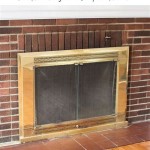Modern Gas Stove Fireplaces: A Comprehensive Overview
Modern gas stove fireplaces represent a compelling alternative to traditional wood-burning options and offer notable advantages in terms of convenience, efficiency, and aesthetics. These appliances combine the visual appeal of a classic fireplace with the practicality and ease of use associated with gas technology. Their designs range from traditional to contemporary, catering to diverse interior design preferences and architectural styles. These fireplaces offer a controlled and readily available source of supplemental heat, contributing to a comfortable and inviting ambiance within a home. Understanding the key features, benefits, and considerations associated with modern gas stove fireplaces is crucial for homeowners seeking to enhance their living spaces.
Unlike their wood-burning counterparts, gas stove fireplaces eliminate the need for procuring, storing, and handling firewood. The fuel source, typically natural gas or propane, is readily available through existing utility connections or refillable propane tanks. This eliminates the mess and inconvenience associated with wood ashes, soot, and creosote buildup. Operation is simplified through the use of ignition systems, often electronic, that allow for instant start-up and convenient control of the flame height and heat output. The precisely controlled combustion process also contributes to higher energy efficiency and reduced emissions compared to traditional wood-burning fireplaces.
Key Benefits of Modern Gas Stove Fireplaces
Modern gas stove fireplaces offer a multitude of benefits that make them an attractive heating option for homeowners. These benefits span across convenience, efficiency, environmental impact, and aesthetic appeal. Examining these advantages provides a comprehensive understanding of the value proposition offered by these heating appliances.
Convenience and Ease of Use:
This is perhaps the most significant advantage. With a gas stove fireplace, there is no need to chop, stack, or carry firewood. Start-up is instantaneous with the flip of a switch or the press of a button on a remote control. Flame height and heat output can be easily adjusted to suit individual preferences and ambient room temperature. The absence of ashes and soot significantly reduces cleaning requirements, minimizing maintenance time and effort. The convenience aspect makes gas stove fireplaces a practical and appealing option for busy homeowners seeking a supplemental heating source without the hassle of traditional wood-burning.
Energy Efficiency and Cost Savings:
Modern gas stove fireplaces are designed to maximize energy efficiency. They utilize advanced burner technology and heat exchanger systems to extract a greater proportion of the energy from the fuel source. Many models are equipped with thermostats and programmable controls, allowing homeowners to precisely regulate the heat output and minimize energy waste. While the cost of natural gas or propane varies, these fireplaces often prove to be a cost-effective heating solution, especially for zonal heating – heating only the occupied areas of a home. The higher efficiency levels translate to lower fuel consumption compared to older, less efficient wood-burning appliances.
Environmental Friendliness:
Gas stove fireplaces are generally considered to be more environmentally friendly than wood-burning fireplaces. Natural gas and propane burn cleaner than wood, producing significantly fewer particulate emissions, smoke, and other pollutants that can contribute to air quality problems. While the combustion of gas does release carbon dioxide, a greenhouse gas, the overall environmental impact is typically lower than that of wood-burning fireplaces, especially when considering the entire lifecycle of wood – from harvesting to transportation and burning. Furthermore, many gas stove fireplaces meet stringent emission standards, further minimizing their impact on the environment.
Safety Features:
Modern gas stove fireplaces incorporate several safety features designed to protect homeowners. Most models are equipped with oxygen depletion sensors (ODS) that automatically shut off the gas supply if oxygen levels in the room become dangerously low, preventing carbon monoxide poisoning. Safety screens and glass doors prevent accidental contact with the hot surfaces of the fireplace, reducing the risk of burns. Many models also feature automatic shut-off mechanisms in case of malfunction or gas leaks. These built-in safety features ensure the safe and reliable operation of the fireplace.
Aesthetic Versatility:
Gas stove fireplaces are available in a wide range of styles, sizes, and finishes to complement diverse interior design preferences. From traditional cast iron stoves to sleek and contemporary designs, there is a gas stove fireplace to suit virtually any aesthetic. Options include realistic log sets, decorative glass media, and various flame patterns, allowing homeowners to customize the appearance of their fireplaces. This versatility makes gas stove fireplaces an attractive design element that enhances the visual appeal of a living space.Types of Modern Gas Stove Fireplaces
Modern gas stove fireplaces are categorized based on various factors, including venting options, fuel type, and design styles. Understanding these different types is crucial for selecting the appropriate fireplace for a specific home and application. Venting options, in particular, play a significant role in installation requirements and overall performance.
Direct Vent Gas Stove Fireplaces:
These fireplaces are considered the safest and most efficient type. They draw combustion air from outside the home and vent exhaust gases directly outdoors through a sealed system. This prevents the introduction of carbon monoxide and other pollutants into the living space. Direct vent fireplaces can be vented horizontally through a wall or vertically through the roof, offering greater flexibility in installation. Their sealed combustion system also contributes to higher energy efficiency.
Vent-Free Gas Stove Fireplaces:
Also known as ventless fireplaces, these models do not require an external vent. They draw combustion air from the room and release exhaust gases directly back into the living space. Vent-free fireplaces are generally less expensive to install than direct vent models, as they do not require the installation of a venting system. However, they are subject to certain restrictions and regulations due to concerns about indoor air quality. These models typically include oxygen depletion sensors (ODS) to shut off the fireplace if oxygen levels become too low. Many jurisdictions have restrictions or bans on vent-free gas appliances due to potential safety concerns.
B-Vent Gas Stove Fireplaces:
These fireplaces utilize a B-vent chimney to exhaust combustion gases. They draw combustion air from the room and vent exhaust gases up through the chimney. B-vent fireplaces are typically less efficient than direct vent models, as they rely on natural draft to exhaust the gases. This type of fireplace is often used to replace existing wood-burning fireplaces that already have a chimney in place.
Fuel Type Differentiation:
The fuel source is another important distinction. Natural gas fireplaces are connected to an existing natural gas line, providing a readily available and cost-effective fuel supply in areas where natural gas service is available. Propane gas fireplaces, on the other hand, utilize refillable propane tanks. Propane is a suitable option for homes that do not have access to natural gas or for those who prefer the flexibility of a portable fuel source.Factors to Consider When Choosing a Modern Gas Stove Fireplace
Selecting the right gas stove fireplace involves careful consideration of several factors, including heating needs, budget, installation requirements, and aesthetic preferences. A thorough assessment of these factors will ensure that the chosen fireplace meets the specific needs and circumstances of the homeowner.
Heating Needs and Room Size:
The size of the room or area to be heated is a crucial factor in determining the appropriate BTU (British Thermal Unit) output of the fireplace. A fireplace with insufficient BTU output will not adequately heat the space, while one with excessive BTU output may lead to overheating. It is essential to select a fireplace with a BTU rating that is appropriate for the size of the room and the desired level of supplemental heating.
Venting Options and Installation Requirements:
As previously discussed, the venting option significantly impacts installation requirements and costs. Direct vent fireplaces offer the greatest flexibility but may require more extensive installation work. Vent-free fireplaces are the easiest to install but are subject to restrictions and regulations. B-vent fireplaces are suitable for existing chimney systems. It is important to consult with a qualified installer to determine the appropriate venting option and ensure compliance with local building codes.
Budget and Operating Costs:
The initial cost of a gas stove fireplace varies depending on the type, size, features, and brand. It is essential to establish a budget that includes the cost of the fireplace itself, installation fees, venting materials, and any necessary modifications to the existing gas line or electrical system. Operating costs, including the cost of natural gas or propane, should also be considered. Energy-efficient models with programmable controls can help minimize operating costs.
Aesthetic Preferences and Design Compatibility:
The design of the gas stove fireplace should complement the overall aesthetic of the room or home. Consider the style, finish, and size of the fireplace in relation to the existing furniture, décor, and architectural features. Select a fireplace that enhances the visual appeal of the space and creates a cohesive and inviting atmosphere.
Safety Features and Certifications:
Ensure that the chosen gas stove fireplace meets all relevant safety standards and certifications, such as those from Underwriters Laboratories (UL) or Canadian Standards Association (CSA). Look for models with oxygen depletion sensors (ODS), safety screens, and automatic shut-off mechanisms. Proper installation and maintenance are also essential for ensuring safe and reliable operation.
Modern Contemporary Gas Stoves Stovax Gazco

Contemporary Gas Stoves Ivett Reed

Valor Madrona Modern Gas Stove Vancouver Fireplaces

Gas Stoves Fireplace And Stove The Hearth Doctor Inc

Heat Glo Paloma Gas Stove Discontinued

Modern Freestanding Gas Fireplace

Contemporary Gas Stoves Ivett Reed

Gas Stoves The Fireplace Company Aspen Snowmass Carbondale Basalt Glenwood Springs No Name New Castle Silt Crested E Gunnison County And

Freestanding Gas Stove Series

Gas Stoves Made In Usa Lopi








